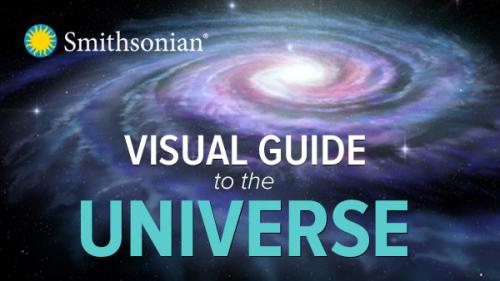TheGreatCoursesPlus - A Visual Guide to the Universe with the Smithsonian
Produced in partnership with the Smithsonian, these 18 lavishly illustrated lectures take you from our solar system to the farthest reaches of space and time.
1: Probing the Cosmos from Space
- Prepare for your cosmic journey by surveying NASA's space exploration strategy. Although human spaceflight gets the lion's share of publicity, the greatest scientific discoveries in space are the work of planetary probes and space observatories. Learn why this approach has paid off so spectacularly.
2: The Magnetic Beauty of the Active Sun
- Explore the sun in astonishing detail through the multispectral instruments of the Solar Dynamics Observatory. See debris from magnetic storms explode into space and then crash back into the sun. Learn how these mammoth outbursts affect Earth.
3: Mars-Water and the Search for Life
- Discover that Mars is a water world whose surface dried up long ago and may once have supported life. Four robotic rovers have landed on Mars, including the sophisticated Curiosity rover, now crawling across the planet searching for clues connected to microbial life forms.
4: Vesta and the Asteroid Belt
- Study fossil remains of the early solar system, preserved in the rocky debris of the asteroid belt between Mars and Jupiter. Focus on one of the largest asteroids, Vesta, viewing it close up via the Dawn spacecraft. Learn how pieces of Vesta have fallen to Earth as meteorites.
5: Saturn-The Rings of Enchantment
- Examine Saturn through the eyes of the Cassini probe, which has been orbiting the ringed planet since 2004, taking spectacular pictures of Saturn's cloud tops, moons, and especially the enigmatic ring system. Examine competing theories for the origin of this complex circular band.
6: The Ice Moons Europa and Enceladus
- Focus on two enigmatic ice worlds: Jupiter's moon Europa and Saturn's moon Enceladus. Both may harbor liquid water beneath their icy crusts. Weigh the chances that life exists in these underground oceans, despite the extreme cold in the outer solar system.
7: The Search for Other Earths
- Join the Kepler telescope in the search for other Earths. Kepler has spotted thousands of candidate planets orbiting other stars, including many that are roughly Earth-sized. Learn how planets are detected at stellar distances, and study the conditions needed to support life.
8: The Swan Nebula
- Venture into a nearby spiral arm of the Milky Way galaxy, as imaged in infrared light by the Spitzer Space Telescope. See how Spitzer's panorama of the Swan nebula reveals that spiral arms are active regions of star formation, showing up brilliantly in the infrared band.
9: The Seven Sisters and Their Stardust Veil
- The Pleiades cluster, or Seven Sisters, is one of the most beautiful star formations in the heavens. Discover the origin of the wispy nebulae that surround these bright stars. In the process, learn how the Hertzsprung-Russell diagram is a powerful tool for estimating the ages of star clusters.
10: Future Supernova, Eta Carinae
- Explore the imminent fate of the luminous star Eta Carinae, a ticking bomb due to explode as a supernova in the next few hundred thousand years. Study the life cycle of stars, and trace the history of Eta Carinae to mysterious events first observed in 1843.
11: Runaway Star, Zeta Ophiuchi
- Why is the enormous star Zeta Ophiuchi careening through our galaxy at unusually high speed? Probe the mystery of this runaway star and its gorgeous shock wave, using images from the Spitzer Space Telescope and other observatories to tell a story of massive interacting stars and a likely supernova explosion.
12: The Center of the Milky Way
- Travel to the most exotic sector of the Milky Way, the galactic center, which has a black hole four million times more massive than the sun and is orbited by hot gas and giant stars. View this violent region at multiple wavelengths using the most advanced telescopes of our day.
13: The Andromeda Galaxy
- Investigate the nearby Andromeda galaxy, tracing its puzzling spiral arms. Use images from the Galaxy Evolution Explorer and other telescopes to gather evidence that something once crashed into Andromeda. Then chart Andromeda's collision course with our own galaxy!
14: Hubble's Galaxy Zoo
- Use the sharp eye of the Hubble Space Telescope to survey some of the most peculiar galaxies in the local universe. Focus on Hoag's Object, a ring galaxy with a yellow nucleus, surrounded by a nearly perfect circle of hot blue stars. Explore competing ideas for the origin of this unique structure.
15: The Brightest Quasar
- Travel to some of the most distant and luminous objects in the universe: quasars. Discovered in the early 1960s, these active galaxies are associated with matter-devouring supermassive black holes. Investigate the brightest and first-found quasar, called 3C 273, and learn what it reveals about the early universe.
16: The Dark Side of the Bullet Cluster
- Investigate mounting evidence that invisible dark matter must exist. Then see how telescopes scanning the sky at different wavelengths have mapped the distribution of dark matter, notably in a collection of distant colliding galaxy clusters called the Bullet Cluster.
17: The Cosmic Reach of Gamma-Ray Bursts
- Search for the origin of the most powerful explosions since the big bang. Known as gamma-ray bursts, these colossal beams of high-energy radiation are among our deepest views into the cosmic past. Also consider the chance that a nearby gamma-ray burst could cause a mass extinction on Earth.
18: The Afterglow of the Big Bang
- Conclude your cosmic tour by probing the echo of creation: the faint afterglow of the big bang, which is present everywhere in space. View this signal in increasing detail provided by spacecraft, and uncover its astonishing story about the earliest epoch of our vast universe.

A.Visual.Guide.to.the.Universe.with.the.Smithsonian.part1.GC.rar
A.Visual.Guide.to.the.Universe.with.the.Smithsonian.part2.GC.rar

































